Packaging 101: The Complete Guide
- Packaging 101
- Types of Packaging
- Aseptic Packaging
- Blister Packaging
- Biodegradable Packaging
- Bulk Packaging
- Carbon Neutral Packaging
- Circular Packaging
- Clamshell Packaging
- Compostable Packaging
- Cornstarch Packaging
- Corrugated Packaging
- Discreet Packaging
- Ecommerce Packaging
- Flexible Packaging
- Frustration Free Packaging
- Retail Packaging
- Secondary Packaging
- Smart Packaging
- Sustainable Packaging
- What is a PR Package?
- What is a Poly Mailer?
- Packaging Design Ideas
- AI Packaging Design
- Bakery Packaging Ideas
- Bath Bomb Packaging Ideas
- Bath Salt Packaging Ideas
- Body Butter Packaging Ideas
- Body Oil Packaging Ideas
- Body Scrub Packaging Ideas
- Brownie Packaging Ideas
- Cake Packaging Ideas
- Cake Pop Packaging Ideas
- Candle Packaging Ideas
- Candy Packaging Ideas
- Canva Packaging Design
- Chocolate Packaging Ideas
- Cinnamon Roll Packaging Ideas
- Clothing Packaging Ideas
- Coaster Packaging Ideas
- Coffee Bag Design Ideas
- Cookie Packaging Ideas
- Cosmetics Packaging Design
- Cotton Candy Packaging Ideas
- Cupcake Packaging Ideas
- DIY Packaging Ideas
- Dog Treat Packaging Ideas
- Food Packaging Ideas
- Empanada Packaging Ideas
- Etsy Packaging Ideas
- French Fries Packaging Ideas
- Frozen Food Packaging Ideas
- Hair Extension Packaging Ideas
- Handbag Packaging Ideas
- Jewelry Packaging Ideas
- Keychain Packaging Ideas
- Lash Packaging Ideas
- Lip Gloss Packaging Ideas
- Macaron Packaging Ideas
- Minimalist Packaging Ideas
- Mug Packaging Ideas
- New Employee Welcome Kit Ideas
- Packaging Colors
- Packaging Inserts Ideas
- Packaging Logo Design
- Packaging Typography
- Perfume Box Design Ideas
- Pizza Box Design Ideas
- Popcorn Packaging Ideas
- Scarf Packaging Ideas
- Skincare Packaging Design Ideas
- Soap Packaging Ideas
- Sock Packaging Ideas
- Sticker Packaging Ideas
- Sunglass Packaging Ideas
- Sustainable Packaging Ideas
- Tea Packaging Ideas
- Wax Melt Packaging Ideas
- Weed Packaging Ideas
- T-Shirt Packaging Ideas
- Wine Packaging Design Ideas
- What is a Packaging Engineer?
- Types of Packaging Materials
- Chipboard vs Cardboard
- Compostable Packaging Materials
- Alternatives to Plastic Packaging
- Edible Packaging Materials
- Food Packaging Materials
- Are Poly Mailers Recyclable?
- How to Recycle Cardboard Boxes
- How to Recycle Packaging Materials
- Medical Device Packaging Materials
- Mono Material Packaging
- Pharmaceutical Packaging Materials
- Plastic Food Packaging
- Protective Packaging Materials
- Reusing Packaging Materials
- Types of Packaging Foam
- Void Fill Packaging
- What is Chipboard?
- What is Kraft Paper?
- Offset vs Digital Printing
- RGB vs CMYK Printing
- Screen Printing vs Digital Printing
- Screen Printing vs Sublimation
- What is a Dieline in Packaging?
- What is Die Cutting?
- What is Digital Printing?
- What is Flexographic Printing?
- What is Glassine Paper?
- What is Offset Printing?
- What is Spot UV Printing?
- Why is 300 DPI Good for Printing?
- How to Estimate Shipping Costs
- How to Pack Glass for Shipping
- How to Mail a Bubble Mailer
- How to Make a Shipping Label
- How To Measure Box Dimensions and Sizes
- How to Ship Alcohol
- How to Ship Artwork
- How to Ship Books
- How to Ship a Cake
- How to Ship Candles
- How to Ship Chocolate
- How to Ship Clothes
- How to Ship Cookies
- How to Ship Food
- How to Ship a Hat
- How to Ship Jewelry
- How to Ship a Laptop
- How to Ship Perfume
- How to Ship a PC
- How to Ship Perishable Food
- How to Ship Plants
- How to Ship Shoes
- How to Ship Vinyl Records
- Packaging Symbols
- Shipping Large Items
- What is a Delivery Exception?
- What is Shipping Insurance?

Discover Phillip Akhzar’s journey, the Founder and CEO of Arka, bringing 16 years of expertise in packaging and supply chain logistics. Read more on Arka.
What is RGB? Key Features
The RGB color model, composed of Red, Green, and Blue, is widely employed in digital imaging and electronic displays. It is crucial to grasp its fundamental aspects, particularly compared to CMYK.
RGB functions on an additive principle, constructing colors through the amalgamation of distinct intensities of red, green, and blue light. These primary colors blend in diverse proportions, resulting in an extensive array of colors. In the realm of digital devices like monitors, cameras, and scanners, RGB stands as the standard for image display and capture.
Each RGB color channel signifies one of the primary hues. The convergence of red, green, and blue channels yields the ultimate color output. Manipulating each channel's intensity enables the generation of myriad colors; for instance, equal intensities of red, green, and blue yield white, while zero intensity yields black.
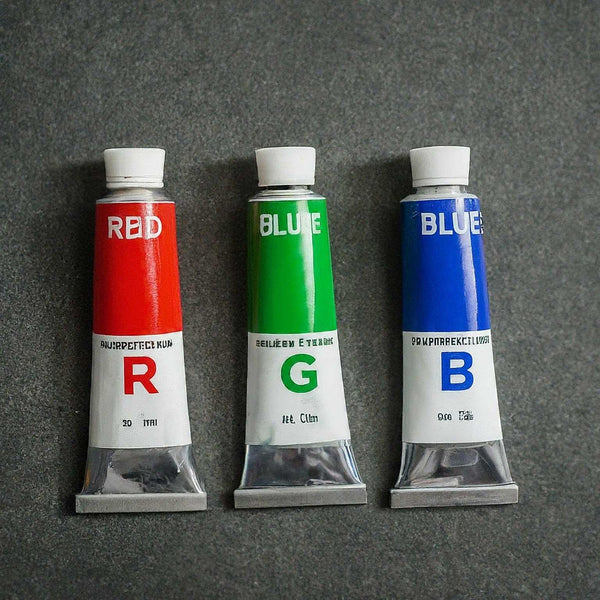
Pros and Cons of Using RGB
Here are the benefits of using RGB:
• Vivid Colors: RGB provides a broad spectrum of vibrant and saturated colors, rendering it ideal for digital displays.
• Versatility: Well-suited for electronic media such as websites, social media, and multimedia presentations.
The common challenges of using RGB are:
• Limited Color Reproduction: RGB may not faithfully reproduce certain colors present in the CMYK spectrum, impacting print results.
• Device Dependence: Colors may appear dissimilar on diverse devices due to variations in screen calibration.
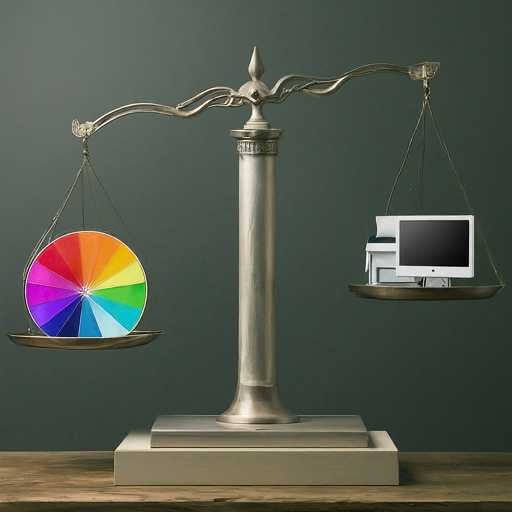
Common RGB Applications
• Web Design: Crafting visually captivating websites with dynamic color schemes.
• Digital Photography: Capturing and showcasing images with precise color representation.
• Graphic Design: Creating digital graphics for online and electronic media.

Optimal File Formats for RGB
The best file formats for RGB are:
• JPEG: Suitable for photographs and images featuring gradients.
• PNG: Appropriate for images with transparency or when lossless compression is imperative.
• GIF: Frequently used for straightforward graphics, icons, and animations.

What is CMYK? Key Features
The CMYK color model, representing Cyan, Magenta, Yellow and Key (black), is tailored for color printing, as opposed to RGB used in electronic displays; in CMYK, colors result from blending varying percentages of these inks, creating a diverse spectrum. For instance, mixing cyan and yellow in different proportions produces various green shades, while the "Key" black adds depth.

Pros and Cons of CMYK
The main advantages of using CMYK are:
• Color Range: CMYK excels in capturing a broad array of colors.
• Print Realism: It is the preferred choice for realistic reproduction of images in print.
Some of the limitations of CMYK are:
• Limited Vividness: CMYK may fall short in reproducing extremely bright and vibrant colors compared to RGB.
• Ink Costs: Printing with four inks can be costlier than the three-color RGB model.
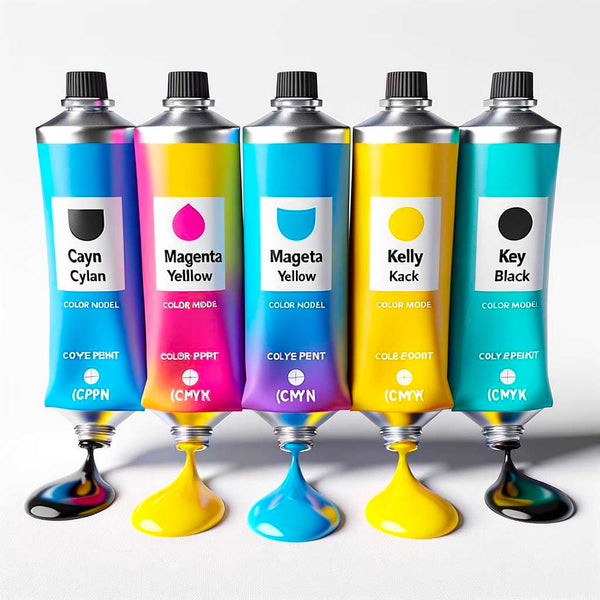
Primary Uses of CMYK
CMYK dominates the printing industry, finding applications in magazines, brochures, packaging etc. It ensures precise, high-quality prints with detailed images and text.
Ideal File Formats for CMYK
When working with CMYK, selecting appropriate file formats is crucial. JPEG, TIFF and PDF stand out as formats that maintain color accuracy and facilitate a smooth printing process.
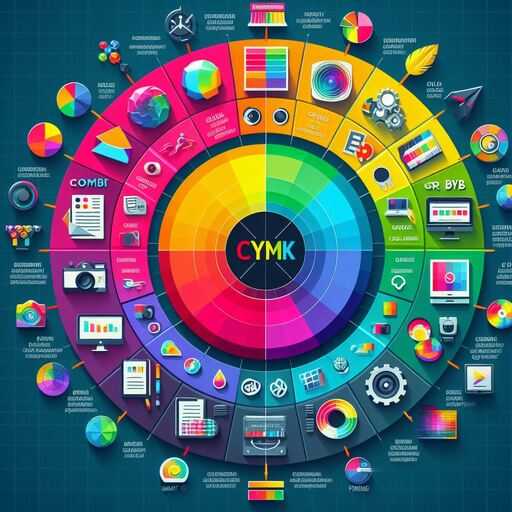
When to Use CMYK vs RGB
In the world of digital design and print media, understanding the difference between RGB vs CMYK is crucial; each color model serves specific purposes, and knowing when to use CMYK vs RGB can greatly impact the outcome of your creative projects.
• Key Differences: RGB is the color model used for electronic displays like monitors, cameras and screens. On the other hand, CMYK is the color model designed for print applications.
• Scenarios for RGB: When working on projects for web design, social media graphics or any digital platform, RGB is the go-to choice; its ability to produce a wide range of vibrant colors is perfect for creating eye-catching visuals that pop on screens. Websites, social media posts and online advertisements primarily utilize the RGB color model to showcase graphics in their full digital glory.
• Scenarios for CMYK: When it comes to traditional print media like brochures, posters and magazines, CMYK takes center stage. Unlike RGB, which emits light, CMYK relies on ink to absorb and reflect light. This makes it the ideal choice for producing accurate and consistent colors on physical prints; CMYK vs RGB printing is a key consideration when working on projects that will be sent to a printing press.
• Web and Digital Applications: In the realm of web and digital applications, RGB dominates due to its ability to represent a broader spectrum of colors; photographers, digital artists and graphic designers working on online content benefit from the vivid color range provided by RGB, enhancing the visual experience for users across various devices.
• Print and Traditional Media: When venturing into the realm of print, designers must understand the significance of CMYK; printers utilize these four ink colors to reproduce a wide array of hues accurately. Choosing the appropriate color model (CMYK vs RGB) ensures that the final print matches the designer's intent, making it essential for creating professional-looking materials.
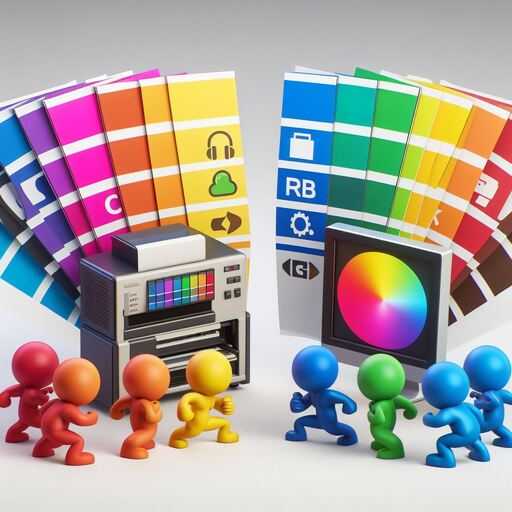
Challenges of Transiting from RGB to CMYK
Transitioning from RGB to CMYK brings along with them several challenges that may end up interfering with print quality, therefore, some vigilance is necessary on the part of the designer for making the best quality prints. For a smooth shift, a good transition can be made by:
• Color Conversion Tools: Utilize reliable color conversion tools to maintain accuracy during the transition.
• CMYK Proofing: Heavily proof CMYK designs before going to the printer to avoid any surprise color shift.
• Open Communication: Stay in communication with printers – know their exclusive needs for better awareness.
Following are the best practices to avoid stumbling blocks and create enthralling designs.
• Start Right in Color Mode: When starting a project, always choose the right color mode.
• Regularly Check Colors: Regularly check your design in RGB and CMYK modes to ensure consistency.
• Use Pantone Colors to Best Effect: Apply the Pantone colors to ensure exact representation in various media.
Mastering the RGB vs CMYK challenge and understanding when each is appropriate will help shine your design on screen or paper.

RGB and CMYK in Design Software
Mastering the color modes in design software like Photoshop, InDesign and Illustrator is crucial for crafting captivating visuals; designers often grapple with a key choice: RGB or CMYK.
RGB reigns supreme in the digital realm, catering to screens and cameras; conversely, CMYK takes the lead in the print domain.
When to use CMYK vs RGB depends on the intended output of your design. Opt for RGB for web or digital projects; its vivid spectrum excels on screens. For print, CMYK is indispensable, ensuring accurate color on paper.
Shifting between RGB and CMYK is a breeze in design software; designers effortlessly toggle between modes, previewing colors for different scenarios—especially useful when transitioning between digital and print.
Understanding what is CMYK vs RGB is fundamental for achieving consistent and accurate results in your design projects. RGB dazzles in digital, while CMYK is tailored for print; balancing both is vital for preserving your color palette's integrity in designs spanning both worlds.

Final Thoughts
In the vibrant world of design, the preference for RGB vs CMYK isn't just a technical matter; it's a strategic choice that molds how your creations visually resonate. Knowing when to use CMYK over RGB ensures that your designs communicate effectively, whether on screens or in print. When dealing with printing considerations, the RGB or CMYK quandary is addressed by aligning your choices with the display medium.
For businesses seeking smooth packaging solutions, Arka excels in transforming lively digital designs into accurately printed realities. With Arka, the RGB or CMYK decision becomes a straightforward process, guaranteeing that your packaging mirrors your brand's authentic essence.
We can help create the most appealing custom packaging for your brand; go ahead and check out our premium custom mailer boxes and shipping boxes; let’s create top-notch packaging for your business together!
FAQs on CMYK vs RGB
Why do colors sometimes look different on my screen and in print?
Colors may vary due to different color modes. RGB is ideal for screens, while CMYK is better for print; adjusting color settings and consistent modes can help.
Are there any tools to help with color calibration for accurate representation?
Yes, various tools aid in color calibration; utilize tools like colorimeters or calibration software to ensure accurate color representation across devices and prints.

